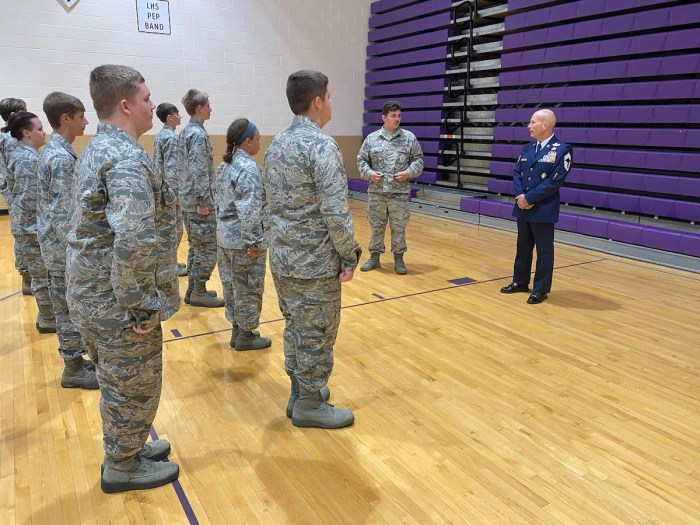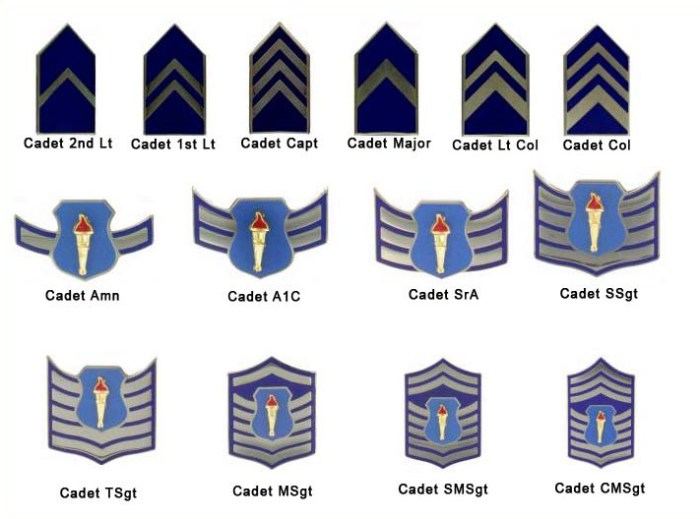Air Force Junior ROTC ranks provide a structured framework for developing leadership skills and fostering discipline among cadets. This comprehensive guide delves into the hierarchical structure, responsibilities, advancement criteria, and insignia associated with each rank within the program.
The Air Force Junior ROTC program utilizes its rank structure to instill a sense of responsibility, teamwork, and leadership among its cadets. Through hands-on experiences and structured training, cadets learn the importance of discipline, respect, and integrity.
Ranks within Air Force Junior ROTC

Air Force Junior ROTC (AFJROTC) is a program that provides high school students with an opportunity to learn about the United States Air Force and prepare for a career in the military or civilian life.
The AFJROTC program has a hierarchical structure of ranks, which are used to indicate the level of responsibility and authority that a cadet has.
Cadet Ranks
The cadet ranks in AFJROTC are as follows:
- Cadet Airman Basic
- Cadet Airman
- Cadet Senior Airman
- Cadet Master Sergeant
- Cadet First Sergeant
- Cadet Chief Master Sergeant
- Cadet Second Lieutenant
- Cadet First Lieutenant
- Cadet Captain
- Cadet Lieutenant Colonel
- Cadet Colonel
The hierarchical structure of the cadet ranks is as follows:
- Cadet Airman Basic is the lowest rank in AFJROTC.
- Cadet Airman is the next highest rank.
- Cadet Senior Airman is the next highest rank.
- Cadet Master Sergeant is the next highest rank.
- Cadet First Sergeant is the next highest rank.
- Cadet Chief Master Sergeant is the next highest rank.
- Cadet Second Lieutenant is the lowest commissioned officer rank in AFJROTC.
- Cadet First Lieutenant is the next highest commissioned officer rank.
- Cadet Captain is the next highest commissioned officer rank.
- Cadet Lieutenant Colonel is the next highest commissioned officer rank.
- Cadet Colonel is the highest commissioned officer rank in AFJROTC.
Cadets are promoted to higher ranks based on their performance in the AFJROTC program.
Responsibilities of Each Rank

Within the Air Force Junior ROTC program, each rank carries specific responsibilities that contribute to the program’s overall functioning. These responsibilities range from administrative tasks to leadership roles, ensuring the smooth operation and effectiveness of the program.
Cadet Airman First Class (C/A1C)
As the lowest enlisted rank, Cadet Airman First Class (C/A1C) holds basic responsibilities such as maintaining a clean uniform, performing routine duties, and assisting with administrative tasks. They also serve as role models for junior cadets, demonstrating proper conduct and behavior.
Cadet Airman (C/Amn), Air force junior rotc ranks
Cadet Airman (C/Amn) holds slightly more responsibility than C/A1C. They assist with training and supervising junior cadets, ensuring they understand and follow program regulations. Additionally, C/Amn may take on additional duties, such as serving as a flight commander or assistant instructor.
Cadet Senior Airman (C/SrA)
Cadet Senior Airman (C/SrA) serves as a mentor and guide to junior cadets. They lead training sessions, supervise activities, and provide guidance on personal development. C/SrA also assist with administrative tasks, such as scheduling and managing events.
Cadet Staff Sergeant (C/SSgt)
Cadet Staff Sergeant (C/SSgt) holds a leadership role within the program. They oversee the activities of multiple flights or sections, ensuring that training and discipline standards are maintained. C/SSgt also serve as role models and mentors for junior cadets.
Cadet Technical Sergeant (C/TSgt)
Cadet Technical Sergeant (C/TSgt) holds a key leadership position. They assist the Cadet Commander and other senior cadets in managing the program. C/TSgt may be responsible for specific areas, such as training, operations, or administration.
Air Force Junior ROTC ranks are designed to provide a structured leadership experience for students. While the ranks may not be as well-known as those in the actual Air Force, they still play an important role in developing leadership skills.
If you’re interested in learning more about the Air Force Junior ROTC program, I recommend checking out the truth project lesson 1 . This lesson provides a great overview of the program and its benefits. The Air Force Junior ROTC program can be a great way for students to develop their leadership skills and learn about the Air Force.
Cadet Master Sergeant (C/MSgt)
Cadet Master Sergeant (C/MSgt) is the highest enlisted rank in Air Force Junior ROTC. They serve as the Cadet Commander’s right-hand person, overseeing all aspects of the program. C/MSgt provides leadership, guidance, and support to the entire cadet corps.
Advancement Criteria

Cadets must meet specific criteria to advance through the ranks in Air Force Junior ROTC. These criteria include demonstrating leadership, academic achievement, and participation in extracurricular activities.Cadets are evaluated on their performance in these areas by their instructors. Instructors consider factors such as the cadet’s ability to lead others, their grades, and their participation in community service and other extracurricular activities.
Evaluation Process
The evaluation process for cadet performance is ongoing. Instructors observe cadets in class, during extracurricular activities, and at other events. They also review cadets’ academic records and conduct periodic evaluations.Cadets who meet the advancement criteria are eligible for promotion. Promotions are typically announced at the end of each semester.
Insignia and Uniform Regulations

Air Force Junior ROTC cadets wear distinctive insignia and uniforms that symbolize their rank and affiliation. These uniforms and insignia play a vital role in fostering a sense of discipline, pride, and unity among the cadets.
The insignia worn by cadets include rank insignia, name tags, and unit patches. The rank insignia is displayed on the shoulders of the uniform and indicates the cadet’s rank within the cadet corps. The name tag is worn on the left breast of the uniform and displays the cadet’s name and rank.
The unit patch is worn on the right sleeve of the uniform and identifies the cadet’s unit.
The uniforms worn by cadets vary depending on the occasion. The most common uniform is the Service Dress Uniform (SDU), which is worn for formal events and ceremonies. The SDU consists of a blue jacket, trousers, and skirt, as well as a white shirt and black tie.
Cadets may also wear a flight suit or physical training uniform for specific activities.
The insignia and uniforms worn by Air Force Junior ROTC cadets are not only symbols of rank and affiliation but also serve as a reminder of the values and traditions of the United States Air Force. These uniforms and insignia instill a sense of pride and discipline in the cadets and help them to develop the leadership skills and character traits that are essential for success in the military and beyond.
Leadership Training and Development
The Air Force Junior ROTC program places great emphasis on fostering leadership development among its cadets. The rank structure plays a pivotal role in this process, providing a framework for cadets to learn and practice leadership skills.
Cadets are assigned ranks based on their performance, merit, and demonstrated leadership potential. As they progress through the ranks, they are given increasing responsibilities and opportunities to lead their peers.
Leadership Opportunities
- Command Positions:Cadets holding higher ranks are typically appointed to command positions, such as flight commander, squadron commander, or group commander. These positions provide cadets with the opportunity to lead and motivate their subordinates, plan and execute missions, and make decisions that impact the unit’s performance.
- Staff Positions:Cadets may also be assigned to staff positions, such as adjutant, operations officer, or logistics officer. These positions provide cadets with experience in supporting the unit’s operations, managing resources, and coordinating with other units.
- Special Projects:Cadets may be given the opportunity to lead special projects, such as organizing fundraising events, planning community service activities, or developing training programs. These projects provide cadets with the opportunity to apply their leadership skills in a practical setting and make a positive impact on their community.
FAQ Section: Air Force Junior Rotc Ranks
What is the highest rank in Air Force Junior ROTC?
The highest rank in Air Force Junior ROTC is Cadet Colonel.
What are the responsibilities of a Cadet Lieutenant Colonel?
Cadet Lieutenant Colonels are responsible for leading and mentoring junior cadets, assisting with administrative tasks, and ensuring the smooth operation of the cadet corps.
How do cadets advance through the ranks?
Cadets advance through the ranks based on their performance, leadership skills, and completion of training requirements.